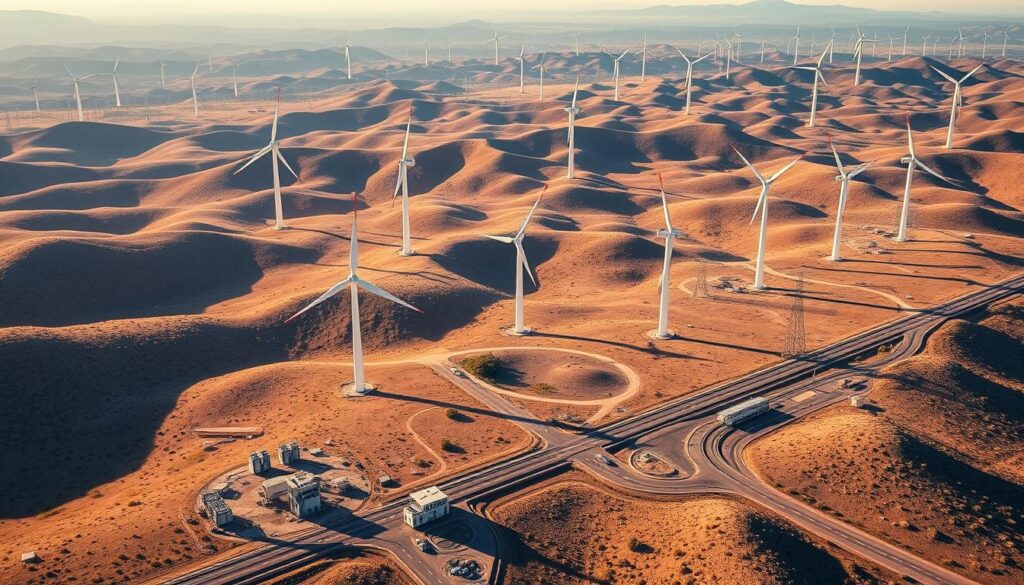Can renewable energy sources meet the world’s growing demands without compromising efficiency or environmental sustainability? As the world shifts toward reducing carbon emissions, wind energy has become a crucial player in the renewable-energy sector.
Technological advancements, particularly the integration of artificial intelligence (AI), are revolutionizing the industry by optimizing wind farm layouts, enhancing energy production, and minimizing environmental impact.
By leveraging high-resolution geospatial data, environmental and economic analysis, and AI-powered predictive modeling, the industry is poised to significantly improve the efficiency of wind energy production.
Key Takeaways
- AI-driven frameworks optimize wind farm layouts for maximum energy production.
- High-resolution geospatial data provides crucial environmental and topographic information.
- AI-powered predictive modeling enhances long-term performance and turbine placement.
- Machine learning algorithms identify sensitive ecological areas through satellite imagery analysis.
- Economic analysis models evaluate infrastructure development and grid connectivity costs.
Understanding Wind Farm Infrastructure Design
As the world shifts towards renewable energy, the importance of well-designed wind farm infrastructure cannot be overstated. Effective design is crucial for maximizing energy output while minimizing environmental impact.
The integration of AI-driven frameworks in wind farm development has revolutionized the way infrastructure is conceptualized and designed. These frameworks leverage high-resolution geospatial data, environmental and economic analysis, and AI-powered predictive modeling to create efficient wind-energy solutions.
Key Components of Wind Farm Infrastructure
Wind farm infrastructure comprises several key components that work together to generate and transmit electricity. These include:
- Wind turbines with advanced blade designs
- Foundation systems tailored to the terrain
- Electrical collection systems
- Transmission infrastructure to connect to the grid
- Access roads for maintenance and construction
For a comprehensive understanding, let’s examine the typical costs associated with these components in a tabular format:
| Component | Cost Range (per unit) | Factors Influencing Cost |
|---|---|---|
| Wind Turbines | $1.3 million – $2.2 million | Turbine size, manufacturer, technology |
| Foundation Systems | $200,000 – $500,000 | Soil conditions, turbine size |
| Electrical Collection Systems | $150,000 – $300,000 | Distance to substation, cable type |
For more detailed information on wind farm infrastructure, you can visit https://www.augi.com/articles/detail/wind-farm-infrastructure.
Importance of Efficient Design
Efficient design is paramount for the success of wind farm projects. It not only maximizes energy production but also minimizes costs and environmental impact. AI-driven frameworks play a crucial role in achieving this efficiency by optimizing turbine placement, predicting maintenance needs, and streamlining the construction process.
Efficient design leads to:
- Maximized energy output
- Reduced construction and maintenance costs
- Minimized environmental footprint
By embracing AI-driven design and focusing on the key components of wind farm infrastructure, developers can create sustainable and efficient renewable energy projects that meet the growing demand for clean energy.
Site Selection for Wind Farms
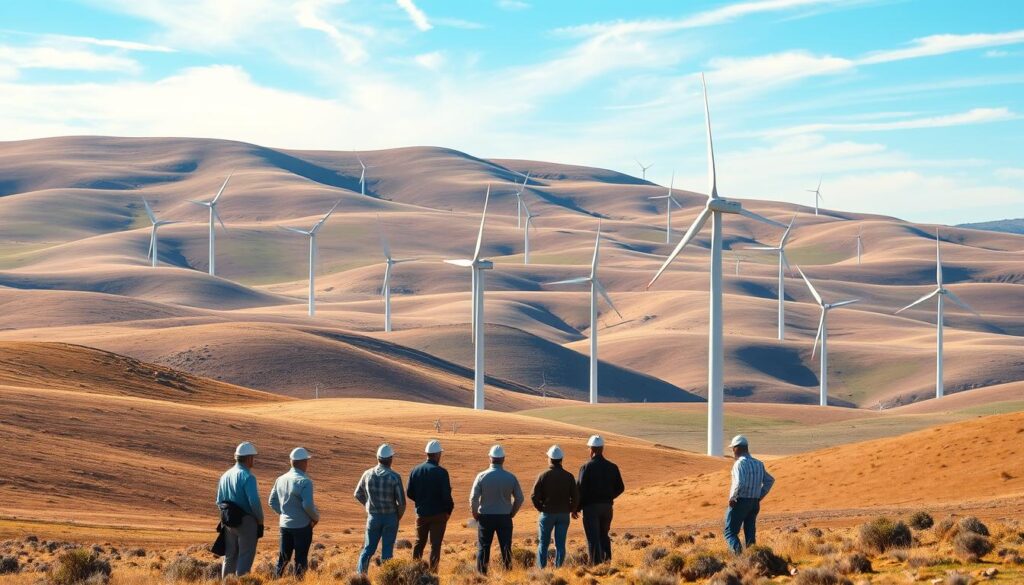
Wind farm site selection is a critical process that determines the overall performance of the farm. One of the foundational steps in this process is the use of advanced tools and technologies to analyze potential sites.
Advanced tools such as Google Earth Engine, QGIS, and ArcGIS allow planners to visualize landscapes and analyze critical parameters such as elevation, slope, and land-cover types. These tools are essential in identifying suitable locations for wind farms.
Factors Influencing Site Choice
Several factors influence the choice of a site for a wind farm. These include wind speed, direction, and seasonal variations. Meteorological analysis is crucial in understanding wind patterns, and platforms such as the Weather Research and Forecasting (WRF) model and ERA5 provide historical and real-time data on these parameters.
For more detailed information on site selection, you can visit https://windexchange.energy.gov/projects/site-selection, which offers comprehensive insights into the process.
Environmental Considerations
Environmental considerations play a significant role in site selection. Factors such as wildlife habitats, water sources, and cultural heritage sites must be taken into account to minimize the environmental impact of the wind farm.
Proximity to Power Grids
The proximity of a wind farm to existing power grids is another critical factor. Being close to power grids reduces the cost of connecting the wind farm to the grid, thereby enhancing the overall efficiency of the project.
In conclusion, the site selection process for wind farms involves a comprehensive evaluation of various factors, including environmental considerations and proximity to power grids. By leveraging advanced tools and technologies, developers can identify optimal locations for wind farms, ensuring maximum efficiency and productivity.
Wind Turbine Types and Selection
Wind turbine selection is a critical aspect of wind farm design, influencing overall efficiency. The choice of turbine affects not only the energy output but also the environmental impact and operational costs of the wind farm.
Horizontal Axis vs. Vertical Axis Turbines
Wind turbines are primarily categorized into two types: Horizontal Axis Wind Turbines (HAWT) and Vertical Axis Wind Turbines (VAWT). HAWTs are the most common type, characterized by their large blades rotating around a horizontal axis. They are known for their high efficiency and are widely used in commercial wind farms.
VAWTs, on the other hand, have blades that rotate around a vertical axis. They are less common but offer advantages in certain conditions, such as being able to capture wind from any direction without the need for yaw control.
Evaluating Turbine Efficiency
Turbine efficiency is a crucial factor in wind farm performance. It is determined by the turbine’s ability to convert wind kinetic energy into electrical energy. Factors influencing efficiency include blade design, generator type, and control systems.
A study led by MIT’s Michael F. Howland found that most existing utility-scale turbines are controlled ‘greedily’ and independently, which can lead to suboptimal performance. Advanced control strategies that optimize turbine interactions can significantly improve overall wind farm efficiency.
Sizing Turbines for Optimal Performance
Sizing turbines appropriately is vital for maximizing energy production. Larger turbines can capture more energy but may also increase costs and environmental impacts. The optimal size depends on factors such as wind speeds, site conditions, and project economics.
| Turbine Characteristic | Horizontal Axis Turbines | Vertical Axis Turbines |
|---|---|---|
| Efficiency | High | Moderate |
| Cost | Generally Higher | Variable |
| Maintenance | More Complex | Simpler |
By understanding the different types of wind turbines and their characteristics, developers can make informed decisions to optimize wind farm design and operation.
Layout and Spacing of Wind Turbines
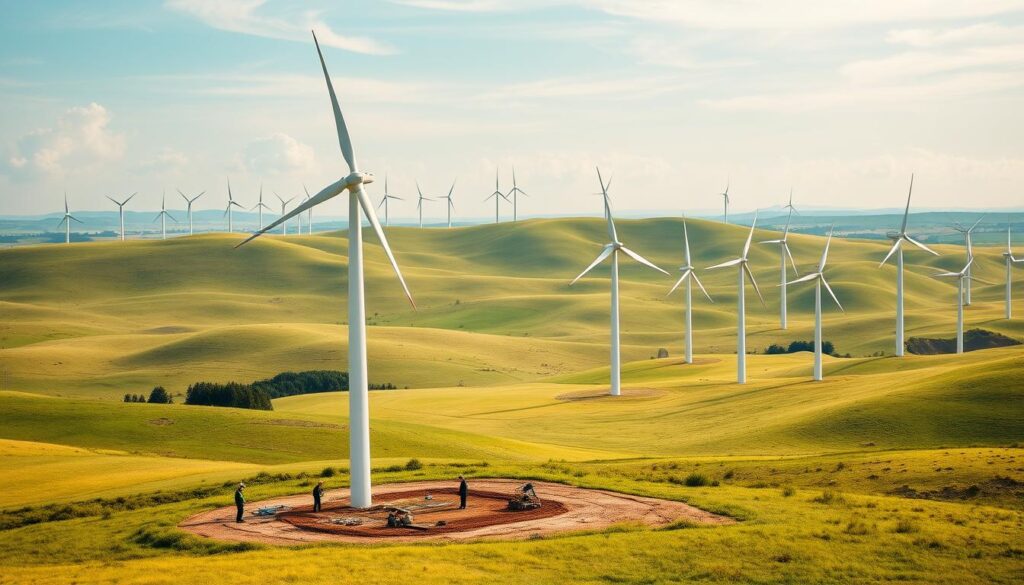
Effective wind turbine layout and spacing are vital components of eco-friendly wind farm construction practices. The strategic placement of turbines can significantly impact the overall efficiency and energy output of a wind farm.
Optimal Turbine Spacing Guidelines
The spacing between wind turbines is a critical factor in minimizing interference and maximizing energy production. Research suggests that turbines should be spaced between 3 to 5 rotor diameters apart to reduce wake effects.
By turning one turbine just slightly away from its own maximum output position — perhaps 20 degrees away from its individual peak output angle — the resulting increase in power output from one or more downwind units will more than make up for the slight reduction in output from the first unit.
| Turbine Spacing (Rotor Diameters) | Energy Production Impact |
|---|---|
| 3 | 5% reduction due to wake effects |
| 5 | 2% reduction due to wake effects |
| 7 | Minimal wake effects |
Micro-siting Techniques
Micro-siting involves the precise placement of turbines to optimize energy production based on local wind patterns and terrain. This technique requires detailed wind resource assessments and computational modeling.
Advanced micro-siting techniques can lead to significant improvements in wind farm efficiency. For instance, using lidar technology to measure wind speeds and directions can help in optimizing turbine placement.
Impact of Terrain on Layout
The terrain of a wind farm site can significantly influence the layout and spacing of turbines. Hilly or complex terrains require more sophisticated micro-siting to account for variations in wind flow.
In conclusion, the layout and spacing of wind turbines are crucial for the efficiency and effectiveness of wind farms. By applying optimal spacing guidelines, utilizing micro-siting techniques, and considering the impact of terrain, wind farm developers can significantly enhance energy production while adhering to eco-friendly wind farm construction practices.
Foundation Design for Wind Turbines
The foundation of a wind turbine is a critical component that ensures the stability and longevity of the entire structure. Innovative wind farm engineering solutions are crucial in this aspect, as they directly impact the performance and lifespan of the turbines.
Types of Foundations Used
Wind turbine foundations can be broadly categorized into several types, each with its unique characteristics and applications. The most common types include:
- Shallow foundations, such as spread foundations or mat foundations, which are suitable for stable soil conditions.
- Deep foundations, like piles or caissons, used when the soil near the surface is unstable or weak.
- Gravity foundations, which rely on their mass to resist overturning forces.
The choice of foundation type depends on various factors, including soil conditions, turbine size, and environmental factors.
Soil Testing and Analysis
Soil testing and analysis are vital components of wind turbine foundation design. They help determine the soil’s properties and behavior under different conditions. Accurate soil data is essential for designing a foundation that can withstand various loads and stresses.
Soil testing typically involves collecting samples from the site and conducting laboratory tests to determine parameters such as density, cohesion, and friction angle. These parameters are then used in the design process to ensure the foundation’s stability.
“The accuracy of soil testing directly influences the reliability and performance of the wind turbine foundation.”
Durability Considerations
Durability is a critical aspect of wind turbine foundation design, as it directly affects the structure’s lifespan and maintenance needs. Factors influencing durability include environmental conditions, material quality, and design robustness.
| Factor | Impact on Durability |
|---|---|
| Corrosion | Can weaken structural elements over time. |
| Material Quality | High-quality materials enhance durability. |
| Environmental Conditions | Extreme weather and soil conditions can affect durability. |
By considering these factors and incorporating innovative engineering solutions, wind turbine foundations can be designed to be both durable and efficient.
Power Collection and Distribution Systems
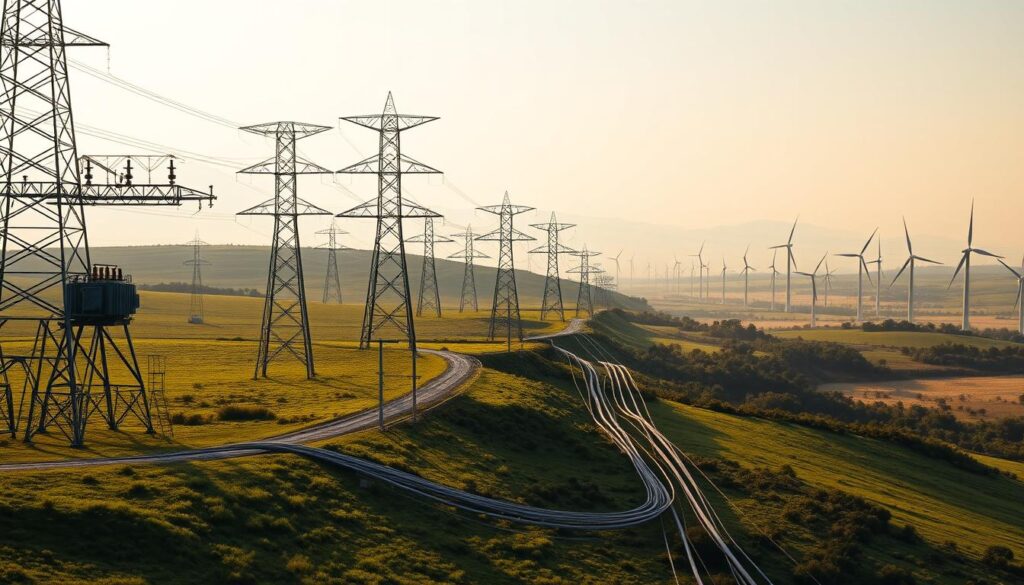
Optimizing power collection and distribution systems is key to enhancing the overall performance of wind farms. Efficient energy transmission networks play a vital role in ensuring that the energy generated by wind turbines is transmitted reliably to the power grid.
Types of Electrical Systems
Wind farms utilize various types of electrical systems to collect and distribute power. The most common systems include:
- Medium voltage collection systems that gather power from individual turbines.
- High-voltage transmission systems that transport the collected power to the grid.
- Substation infrastructure that steps up the voltage for transmission.
Efficient design of these systems is crucial to minimize energy losses and ensure reliable operation.
Grid Integration Strategies
Integrating wind farm output with the existing power grid requires sophisticated strategies. This includes:
- Advanced forecasting techniques to predict wind power output.
- Power conditioning systems to ensure the quality of the electricity supplied.
- Grid stabilization measures to maintain grid stability during fluctuations in wind power.
Effective grid integration enables wind farms to supply power reliably and efficiently, supporting overall grid stability.
Energy Storage Solutions
Energy storage solutions are becoming increasingly important for wind farms to mitigate the intermittency of wind power. Technologies such as batteries and other innovative storage solutions help stabilize the grid by storing excess energy generated during high wind periods for release during calm periods.
The integration of energy storage with wind farms enhances their flexibility and reliability, making them more viable as a primary source of renewable energy.
Roads and Transportation Infrastructure
Roads and transportation infrastructure play a crucial role in the successful development of wind farms. Efficient transportation systems are essential for the delivery of large turbine components and for facilitating maintenance activities throughout the lifespan of the wind farm.
Access Roads for Construction and Maintenance
The construction of access roads is a critical component of wind farm infrastructure design. These roads must be capable of supporting the heavy loads associated with turbine components, such as blades and towers, during the construction phase. Moreover, they must remain durable and accessible for maintenance vehicles throughout the operational life of the wind farm.
Key considerations for access road design include:
- Load-bearing capacity to support heavy construction equipment and turbine components
- Drainage and surface stability to withstand various weather conditions
- Route optimization to minimize environmental impact and construction costs
Transportation of Turbine Components
The transportation of turbine components is a complex logistical challenge due to the large size and weight of these parts. Specialized transportation equipment and careful route planning are necessary to ensure safe and efficient delivery to the wind farm site.
Effective strategies for transporting turbine components include:
- Utilizing oversized load permits and escorts for large components
- Selecting routes that minimize obstacles such as low bridges and narrow roads
- Coordinating with local authorities to manage potential disruptions
Managing Traffic during Construction
Managing traffic during the construction phase of a wind farm is crucial to ensure safety and minimize disruptions to local communities and the environment. This involves planning for the movement of construction vehicles and personnel, as well as implementing measures to mitigate the impact on local traffic.
Best practices for managing traffic include:
| Strategy | Description | Benefits |
|---|---|---|
| Traffic Planning | Coordinating construction schedules with local traffic patterns | Reduces congestion and enhances safety |
| Signage and Alerts | Informing the public about construction activities and road closures | Minimizes disruptions and improves community relations |
Environmental Impact Assessments
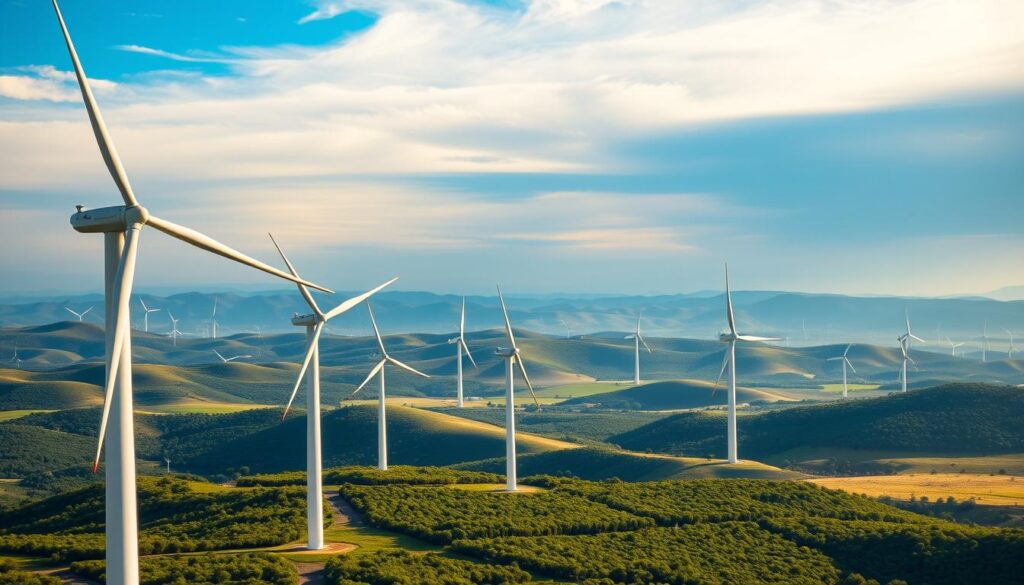
Conducting thorough environmental impact assessments is crucial for sustainable wind farm development. As wind energy continues to grow, it’s essential to ensure that projects are designed and implemented in an eco-friendly manner.
Importance of Environmental Studies
Environmental studies are vital in identifying potential ecological risks associated with wind farm development. These studies help in understanding the impact on local wildlife, including birds and bats, and assessing the effects on the surrounding ecosystem. By leveraging AI-driven solutions, developers can incorporate ecological factors into the planning process, minimizing negative impacts. For instance, machine learning algorithms can analyze satellite imagery to identify sensitive ecological areas.
Mitigation Measures
Once potential environmental impacts are identified, effective mitigation measures must be implemented. This can include:
- Adjusting turbine placement to avoid sensitive habitats
- Implementing noise reduction strategies
- Creating wildlife-friendly habitats around the wind farm
For more information on managing complex projects like wind farm developments, visit this resource on civil engineering project management.
Sustainability in Design
Sustainability is at the core of wind farm development. By incorporating eco-friendly wind farm construction practices, developers can minimize the overall environmental footprint. This includes using sustainable materials, reducing waste, and ensuring that the project enhances the local ecosystem. Sustainable design not only benefits the environment but also improves the project’s long-term viability and community acceptance.
By prioritizing environmental impact assessments and incorporating AI-driven solutions, the wind energy sector can continue to grow in a sustainable and responsible manner.
Community Engagement and Stakeholder Involvement
Engaging with local stakeholders is essential to address concerns and build trust in wind farm projects. Effective community engagement can make a significant difference in the success of a wind farm development.
Importance of Local Input
Local input is vital in understanding the specific needs and concerns of the community where the wind farm is to be developed. This involves conducting thorough community surveys and engaging in open dialogue with residents.
Benefits of Local Input:
- Understanding community values and concerns
- Identifying potential issues early in the project
- Fostering a sense of community ownership
Building Community Support
Building community support requires transparent communication and the involvement of local stakeholders in the decision-making process. This can be achieved through public meetings, workshops, and regular updates on the project’s progress.
The Howland Lab and international teams are working together to refine models for wind turbine layout optimization, aiming for autonomous, cooperative control to maximize power output.
Addressing Concerns of Residents
Addressing the concerns of residents is crucial for maintaining community support throughout the project. This involves providing clear information about the project’s benefits and addressing any misconceptions.
| Concerns | Mitigation Strategies |
|---|---|
| Noise pollution | Implementing noise reduction technologies |
| Visual impact | Conducting visual impact assessments and incorporating community feedback |
| Economic benefits | Highlighting job creation and local economic growth |
Innovative wind farm engineering solutions, such as those being developed by the Howland Lab, are not only improving the efficiency of wind farms but also helping to address community concerns through better design and operation practices.
Regulatory Approvals and Permitting
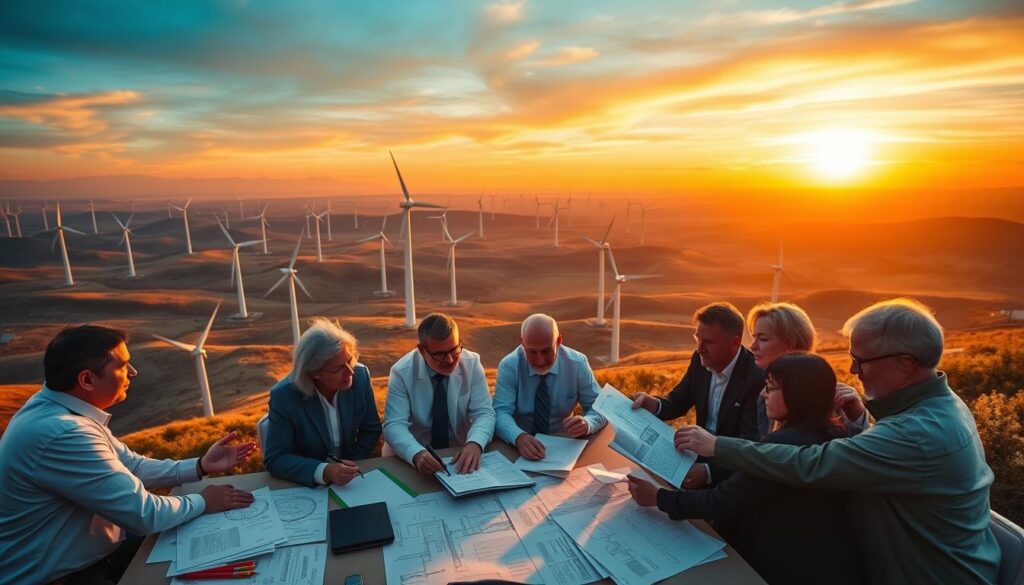
Wind farm projects must navigate a complex landscape of regulatory approvals and permitting processes. This involves understanding and complying with a myriad of local, state, and federal regulations to ensure the project’s viability and minimize potential delays or legal issues.
Navigating Local and Federal Regulations
The regulatory framework for wind farms is multifaceted, involving various levels of government. Local regulations may dictate aspects such as zoning, noise levels, and visual impact, while federal regulations focus on broader environmental and technical standards. To navigate this complex landscape, developers must engage with multiple stakeholders, including local communities, environmental agencies, and energy regulatory bodies.
For instance, the process of permitting a wind energy project involves several steps, from initial site assessment to final approval. This includes conducting environmental impact assessments and ensuring compliance with specific regulations related to wildlife protection and cultural heritage sites.
Permitting Processes Overview
The permitting process for wind farms is comprehensive, requiring detailed documentation and analysis. Key components include:
- Environmental impact assessments to evaluate potential effects on local ecosystems.
- Technical assessments to ensure the wind farm’s design and operation meet safety and efficiency standards.
- Public consultations to address community concerns and gather feedback.
By understanding and adhering to these processes, developers can mitigate risks and ensure a smoother path to project completion.
Compliance with Zoning Laws
Zoning laws play a critical role in determining the suitability of a site for wind farm development. These laws regulate aspects such as land use, setback requirements, and noise levels. Compliance with zoning laws is essential to avoid legal challenges and potential project delays.
Developers must work closely with local authorities to understand specific zoning requirements and ensure that their project complies with all relevant regulations. This may involve negotiating zoning variances or implementing design modifications to meet local standards.
To avoid the threat of costly maintenance and lost revenue, wind farm operators should deploy reliable, fault-tolerant devices with extended mean time between failure (MTBF) rates. This approach not only enhances the overall efficiency of the wind farm but also contributes to a more sustainable energy production process.
Cost Considerations in Wind Farm Infrastructure Design
The economic viability of wind farm projects hinges on meticulous infrastructure design and cost management. Beyond environmental factors, economic considerations play a critical role in wind-farm optimization.
Budgeting for Construction and Maintenance
Effective budgeting for wind farm construction and maintenance is essential for the long-term success of the project. This involves not only the initial investment in turbines and infrastructure but also ongoing expenses such as maintenance, repair, and potential upgrades.
Key cost components include land acquisition, infrastructure development, grid connectivity, and transportation logistics. Each of these elements requires careful planning and budgeting to ensure that the project remains financially viable.
- Land acquisition costs, including lease or purchase agreements
- Infrastructure development, such as roads and turbine foundations
- Grid connectivity, including transmission lines and substations
- Transportation logistics for turbine components and other equipment
Cost-Benefit Analysis of Different Designs
Conducting a thorough cost-benefit analysis is crucial when evaluating different wind farm infrastructure designs. This analysis helps developers determine which design offers the best balance between cost and performance.
Factors to consider in a cost-benefit analysis include the efficiency of the turbines, the durability of the infrastructure, and the potential for future upgrades or expansions. By weighing these factors, developers can make informed decisions that optimize their investment.
| Design Element | Cost Considerations | Benefits |
|---|---|---|
| Turbine Type | Initial investment, maintenance costs | Efficiency, energy production |
| Infrastructure Materials | Material costs, durability | Longevity, reduced maintenance |
| Grid Connectivity | Transmission line costs, substation costs | Reliable energy transmission, grid stability |
Innovations in Wind Farm Technology
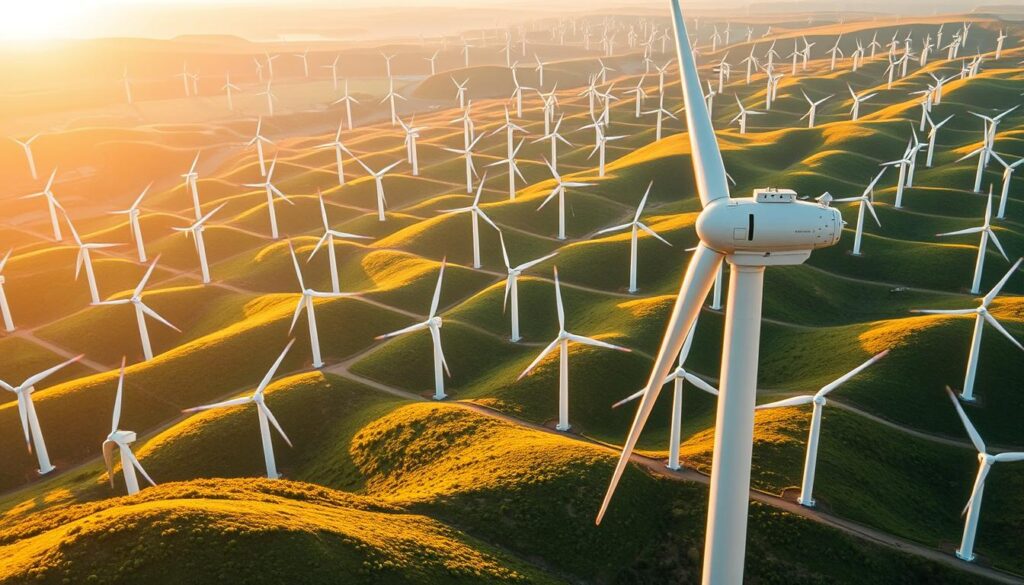
The wind energy sector is witnessing significant technological advancements, transforming the way wind farms are designed and operated. Innovations in wind farm technology are crucial for enhancing efficiency and reducing costs in renewable energy infrastructure planning.
These advancements are not limited to turbine design but also encompass smart grid technologies and the integration of digital twins in design processes. As the demand for renewable energy grows, the role of technology in shaping the future of sustainable energy becomes increasingly important.
Advances in Turbine Design
Recent years have seen significant improvements in turbine design, leading to more efficient energy production. Advances in turbine design include larger rotor diameters, higher hub heights, and more sophisticated blade designs. These improvements enable turbines to capture more wind energy, reducing the overall cost of energy production.
Moreover, the use of advanced materials and manufacturing techniques has contributed to the development of more durable and efficient turbines. As a result, wind farms can now generate more power while minimizing maintenance costs.
Smart Grid Technologies
The integration of smart grid technologies is revolutionizing the way wind energy is transmitted and distributed. Smart grids enable real-time monitoring and management of energy flow, improving the overall efficiency of the grid.
By leveraging advanced sensors and IoT technologies, smart grids can predict energy demand and adjust supply accordingly. This capability is particularly important for wind energy, as it allows for better integration of variable wind power into the grid.
For more information on how technology is shaping the future of energy infrastructure, visit World Civil Society.
Role of Digital Twins in Design
Digital twins are virtual replicas of physical assets, such as wind turbines or entire wind farms. They play a crucial role in the design and operation of modern wind farms by enabling predictive maintenance and performance optimization.
By creating a digital twin of a wind farm, operators can simulate various scenarios, predict potential issues, and optimize performance. This capability is particularly valuable in wind turbine layout optimization, as it allows developers to test different configurations and identify the most efficient layout.
The use of digital twins also extends to predictive maintenance, where AI algorithms analyze data from sensors to predict when maintenance is required. This proactive approach reduces downtime and improves overall turbine performance.
Maintenance and Operational Strategies
Regular maintenance is key to ensuring the optimal performance of wind turbines. Effective maintenance strategies not only prolong the lifespan of the turbines but also maximize energy production, contributing to the overall efficiency of the wind farm.
Regular Maintenance Practices
Regular maintenance practices are foundational to the successful operation of wind farms. This includes routine inspections, lubrication of moving parts, and replacement of worn-out components. By adopting a proactive maintenance schedule, wind farm operators can identify and address potential issues before they escalate into major problems.
Moreover, regular maintenance helps in maintaining the structural integrity of the turbines, ensuring they continue to operate within designed parameters. This not only enhances the safety of the operation but also supports the longevity of the turbines.
Predictive Maintenance Technologies
Predictive maintenance powered by AI and IoT technologies represents a significant advancement in wind farm maintenance. By analyzing data from various sensors, including vibration monitoring systems and temperature sensors, AI models can predict potential failures before they occur. This enables maintenance teams to take corrective action, thereby minimizing downtime and reducing repair costs.
The integration of predictive maintenance technologies into wind farm operations is a prime example of innovative wind farm engineering solutions. It not only improves the efficiency of maintenance activities but also contributes to the overall sustainability of wind energy production by maximizing output and reducing waste.
Minimizing Downtime
Minimizing downtime is critical for maintaining the economic viability of wind farms. Downtime not only results in lost revenue due to reduced energy production but also incurs additional costs associated with repair and maintenance. By leveraging predictive maintenance and adopting a proactive maintenance approach, wind farm operators can significantly reduce downtime.
Furthermore, implementing eco-friendly wind farm construction practices from the outset can also play a role in minimizing future maintenance needs. By designing and building wind farms with sustainability in mind, operators can reduce the environmental impact and potentially lower maintenance requirements over the life of the project.
Future Trends in Wind Farm Infrastructure
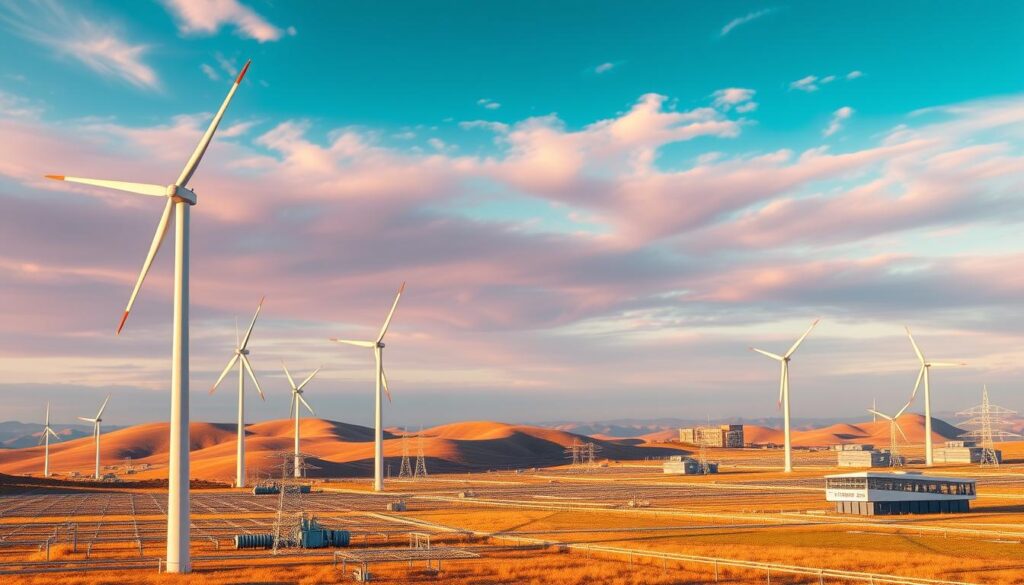
Innovations in wind farm design and operation are paving the way for a more sustainable energy future. As the demand for renewable energy sources continues to grow, the infrastructure supporting wind farms is evolving to meet these needs more efficiently.
Growing Demand for Renewable Energy
The shift towards renewable energy is driven by global efforts to combat climate change and reduce reliance on fossil fuels. Wind energy, in particular, is becoming increasingly important due to its potential for generating clean, sustainable power. Efficient energy transmission networks are crucial for distributing this power to areas of high demand.
According to recent trends, the integration of innovative technologies in wind farm infrastructure is enhancing operational efficiency and energy output. This includes the use of advanced data analytics and AI to optimize turbine performance and predict maintenance needs.
The Role of Policy in Infrastructure Development
Government policies and regulations play a significant role in shaping the development of wind farm infrastructure. Incentives for renewable energy projects, such as tax credits and subsidies, can accelerate the growth of the sector. Conversely, regulatory hurdles can impede progress.
A comprehensive analysis of policy impacts reveals that supportive legislation can foster an environment conducive to investment in wind energy. This, in turn, drives innovation and reduces costs associated with wind farm development.
Innovations Shaping Future Designs
The future of wind farm infrastructure is being shaped by several key innovations, including advancements in turbine technology and the integration of smart grid systems. These developments are enhancing the efficiency and reliability of wind energy production.
| Innovation | Description | Impact |
|---|---|---|
| Advanced Turbine Design | Improved efficiency and reduced noise | Increased energy output |
| Smart Grid Integration | Better management of energy distribution | Enhanced grid stability |
| Predictive Maintenance | Use of AI and data analytics for maintenance scheduling | Reduced downtime and maintenance costs |
As the wind energy sector continues to evolve, the incorporation of wind farm site selection criteria that consider environmental and social factors will become increasingly important. This holistic approach to wind farm development will be crucial in ensuring the long-term sustainability of wind energy as a major component of the global energy mix.
Conclusion: Maximizing Efficiency Through Strategic Design
Efficient wind farm infrastructure design is crucial for maximizing renewable energy output. Strategic planning and design play a significant role in reducing costs and environmental impact.
Key Takeaways
The application of AI in wind farm layout optimization represents a significant step forward in renewable energy infrastructure planning. Through high-resolution geospatial data, AI-driven simulations, and predictive maintenance, the industry is improving efficiency and reducing costs. For more information on wind farm infrastructure, visit Wind Energy: The Facts.
Shaping the Future
As the demand for renewable energy continues to grow, innovations in wind farm technology will be crucial. The integration of AI, smart grid technologies, and digital twins will shape the future of wind energy infrastructure, enabling more efficient and sustainable energy production.
